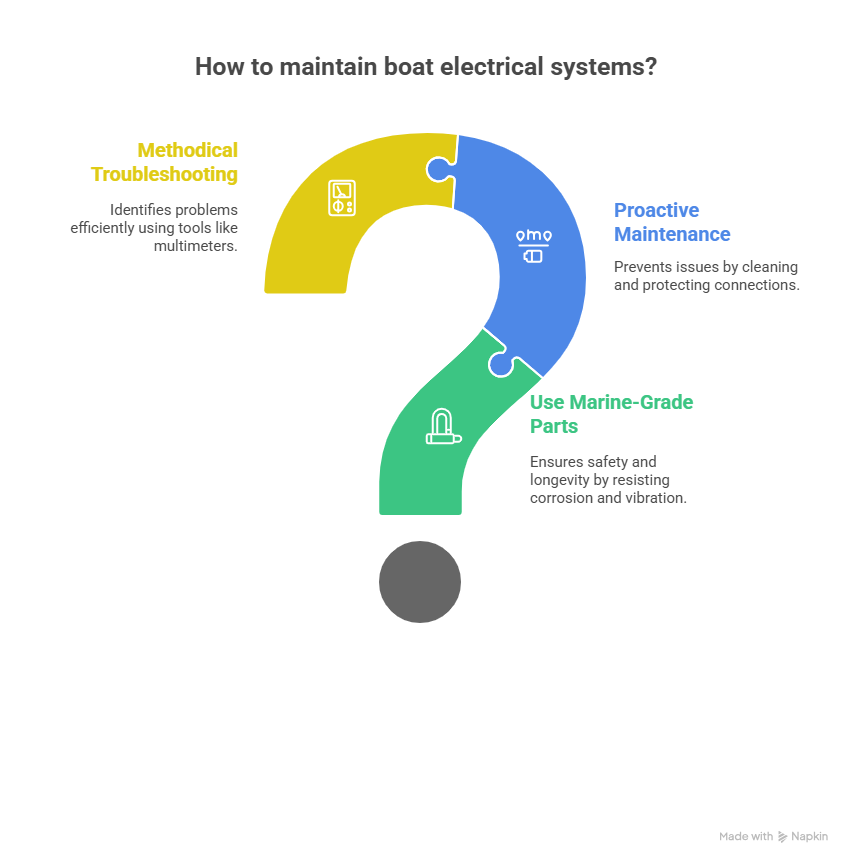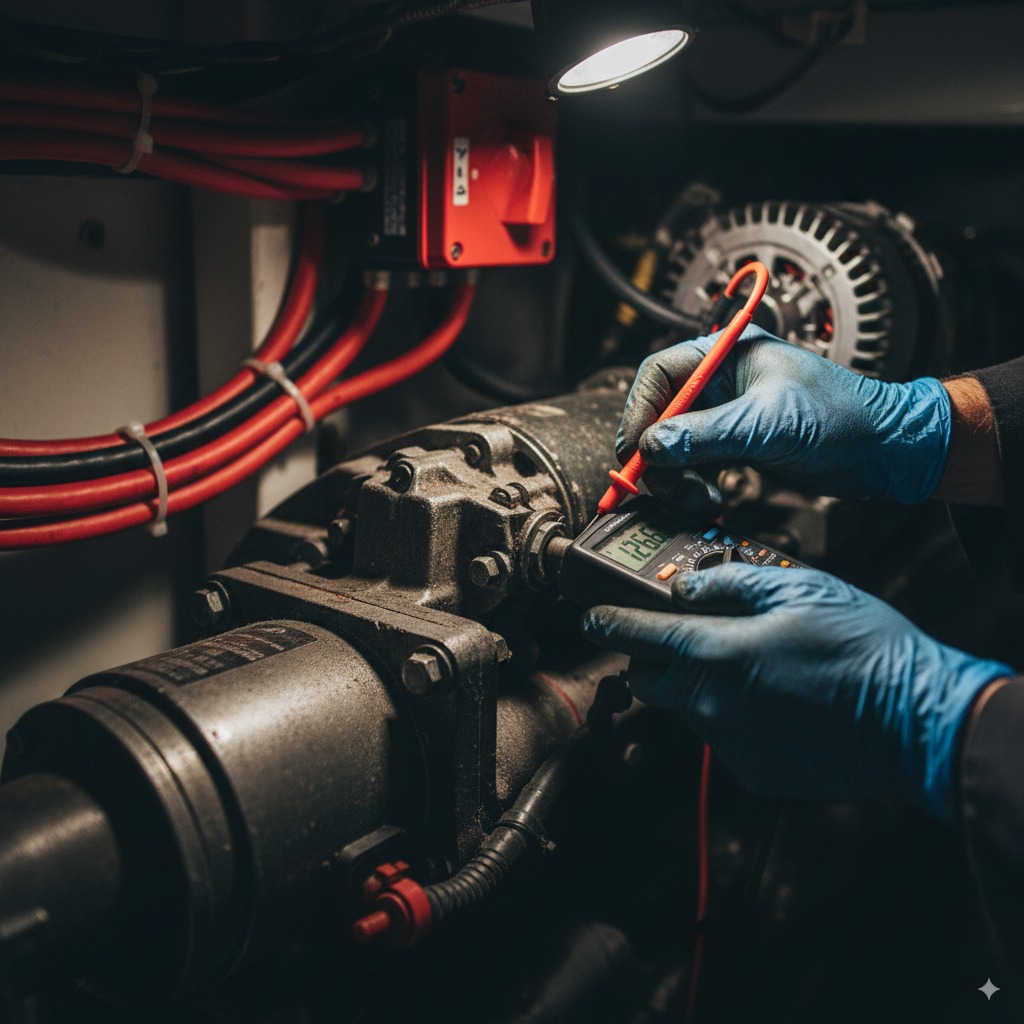A Mechanic’s Guide to Your Boat’s Electrical System
The Day the Lights Went Out on a Sea Ray
I’ll never forget the call. A woman named Maria was dead in the water five miles off Key Biscayne. Her Sea Ray’s engine just quit. No sputter, no smoke, just… silence. When I got out there, it wasn’t a fuel pump or a clogged filter. It was a single, corroded wire on the ignition circuit, hidden under the console. A ten-dollar fix that cost her a thousand-dollar tow and a ruined day.
That’s the thing about electrical systems in marine engines: they’re the ghost in the machine. Everyone worries about the engine block, but it’s the wires, connections, and batteries that cause half the headaches I see at marinas from Miami to Fort Lauderdale. They are the boat’s nervous system, and when they fail, everything stops.
The marine environment, especially our salty, humid Florida air, is brutal on electronics. It’s a constant battle against corrosion, vibration, and moisture. So, let’s pop the hood, and I’ll walk you through how these systems work, what goes wrong, and how you can keep your boat from ending up like Maria’s. This isn’t textbook theory; this is real-world stuff I’ve learned from years of skinned knuckles.
Table of Contents
Why Boat Electrics Are a Special Kind of Headache
A car’s electrical system lives a pretty cushy life. A boat’s? It’s pure combat. You’ve got:
- Saltwater: It’s conductive, corrosive, and it gets everywhere. It’ll turn a shiny new terminal into a green, crusty mess in months.
- Vibration: The constant hum of the engine and the pounding of waves can shake connections loose over time.
- Humidity: It traps moisture in places you can’t see, leading to hidden corrosion that drives you nuts trying to find it.
This is why you can’t just use automotive parts on a boat. Marine-grade components—with their tinned-copper wire, sealed connectors, and robust insulation—are non-negotiable. Trying to save a few bucks on the electrical systems in marine engines by using cheaper parts is the fastest way to set yourself up for failure.
The Core Parts: What Makes It All Tick
Understanding the basic building blocks of the electrical systems in marine engines is the first step. It’s simpler than it looks.
- Power Generation & Storage (Batteries and Alternator): This is your power plant. The batteries give the initial kick to start the engine and run your stuff when it’s off. A healthy 12V battery should sit around 12.6-12.8 volts. If you see it dipping below 12.0V, it’s on its last legs. Once the engine is running, the alternator takes over, recharging the batteries. I always check the alternator output; it should be pushing out 13.8–15.3V to properly charge things.
- The Starting Circuit (Starter & Solenoid): When you turn the key, a massive jolt of power goes to the starter motor, which cranks the engine. If you hear a “click” but no crank, the problem is usually in this circuit.
- Distribution & Protection (Wires, Fuses, Switches): This is the wiring that carries power everywhere else. Fuses and circuit breakers are your safety net—they blow to protect expensive equipment from power surges. Never, ever replace a blown fuse with a bigger one. That’s like disabling the smoke alarm because you keep burning toast. Find out why the fuse blew.
My Usual Suspects: A Quick Diagnostic Cheat Sheet
Over the years, I’ve noticed that most electrical gremlins fall into a few categories. I put this table together from real jobs I’ve done. It’s my mental checklist when I first step on a boat with electrical issues.
| Symptom | My Likely Culprit | First Thing I Check | Ballpark Cost (Miami) |
|---|---|---|---|
| Engine won’t crank, just “clicks” | Bad connection or weak battery | Battery terminals for corrosion & voltage | $50 (cleaning) to $500 (new starter battery) |
| Lights flicker when I start the engine | Loose battery cable or dying battery | Main battery cables at both ends | $20 (tightening) to $300 (new cables) |
| A specific device won’t turn on | Blown fuse or broken wire | Fuse panel and the device’s connection | $5 (fuse) to $250 (tracing & fixing a wire) |
| Battery keeps dying overnight | A “parasitic draw” (something is on) | Use a multimeter to check for current draw with everything off | $150–$400 (to find and fix the draw) |
How to Hunt Down Electrical Gremlins
When something goes wrong with the electrical systems in marine engines, don’t just start replacing parts. That gets expensive fast. Be methodical.
1. Safety First, Always.
Before you touch a single wire, kill all the power. Turn off the battery switches. Electricity and water don’t mix, and a mistake can be deadly. If you see bare wires or smell burning plastic, stop and call a pro. Seriously.
2. The Obvious Stuff.
Start with your eyes. Look for the green crust of corrosion on battery terminals. Check for loose or disconnected wires. Wiggle the main battery cables—they should be rock solid. You’d be amazed how many “catastrophic failures” are just a loose nut.
3. Grab Your Multimeter.
This tool is your best friend.
- Check Battery Voltage: We already covered this. Is it above 12.6V? Good.
- Check for Voltage Drop: If your starter is slow, check the voltage at the starter while a friend turns the key. If it drops way below the battery voltage, you have high resistance (corrosion or a bad cable) somewhere in between. This is a key diagnostic step for electrical systems in marine engines.
- Check for Continuity: If a light doesn’t work, a continuity test will tell you if the wire between the switch and the light is broken somewhere.
Troubleshooting electrical systems in marine engines is a process of elimination. Start with the simplest explanation and work your way to the more complex.

Proactive Care: How to Avoid Calling Me
The best way to deal with electrical problems is to prevent them. Here’s my simple maintenance routine:
- Clean and Protect: Once every couple of months, disconnect your battery terminals, scrub them with a wire brush until they shine, reconnect them tightly, and spray them with a corrosion inhibitor. This alone will prevent half of all starting issues.
- Wiggle Test: When you’re in the engine room, give wires and connections a gentle wiggle. If anything feels loose, tighten it. Vibration is a silent killer of electrical systems in marine engines.
- Keep it Dry: Do what you can to keep your electrical panels and connections dry. A dripping leak above a fuse panel is a disaster waiting to happen.
This isn’t hard work. It’s 15 minutes of prevention that can save you a day of frustration and a fat repair bill. It’s a crucial part of managing the complex electrical systems in marine engines.
The New Stuff: Digital Switching and Beyond
The world of electrical systems in marine engines is changing. We’re seeing more digital switching, where you can control everything from a touchscreen. Lithium batteries are becoming more common because they’re lighter and last longer. These are great advancements, but they also add complexity. My advice? Embrace the tech, but don’t forget the fundamentals. Even the most advanced digital system is still vulnerable to a single corroded ground wire. Staying on top of the basics is key to making sure the electrical systems in marine engines on your boat are reliable.
FAQ: Quick Questions from the Dock
Can I use car parts for my boat’s engine electrics?
Please don’t. A car alternator or starter isn’t ignition-protected. That means it can create a spark, which in a boat’s engine bay full of potential fuel fumes, is incredibly dangerous. Always use marine-rated parts for electrical systems in marine engines.
My battery is a year old and it’s dead. Why?
It was probably either discharged too deeply too many times, or it’s not being charged properly by your alternator. Or you have a parasitic draw slowly draining it. I’d check the alternator output first.
What’s the one tool every boat owner should have for electrical work?
A good quality digital multimeter. You can’t see electricity, so you have to be able to measure it. Learning to use one is not hard and will save you a fortune.
Why do my lights dim when I turn on the bilge pump?
That’s a classic sign of voltage drop. It could mean your wiring is too thin for the load, your connections are corroded, or your battery is on its way out. I’d start by checking the connections at the pump and the battery.
Is it worth upgrading to lithium batteries?
For serious cruisers, absolutely. They are lighter, charge faster, and have a much longer lifespan. For a weekend boater who is always plugged into shore power? Probably overkill. It depends on how you use your boat.
So, What’s the Bottom Line?
At the end of the day, the electrical systems in marine engines don’t have to be a mystery. They run on simple principles. If you remember nothing else from this, remember this:
- Corrosion is Your #1 Enemy: Clean, tight, and protected connections are everything.
- Use the Right Parts: Marine-grade isn’t a marketing gimmick; it’s a safety standard.
- Think Methodically: Don’t guess. Use your eyes and a multimeter to trace the problem from the source.
- Prevention is Cheaper Than a Tow: A little bit of cleaning and tightening goes a long, long way.
Take care of your boat’s electrical system, and it will take care of you. Now go check your battery terminals.
Author Bio
I’m Alex, a 15-year marine technician in South Florida and I’m ABYC-certified in marine electrical systems. I’ve re-wired entire vessels and hunted down electrical gremlins on everything from small center consoles to large sportfishers at marinas like Dinner Key and Bahia Mar. If it involves wires and a boat, I’ve probably fixed it.


Leave a Reply